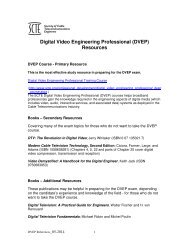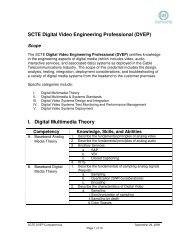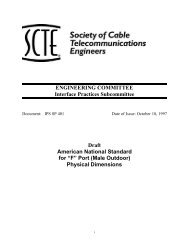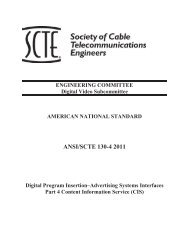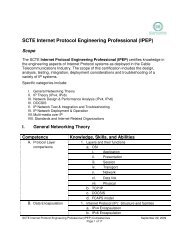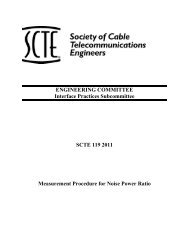ANSI/SCTE 16 2001R2007
ANSI/SCTE 16 2001R2007
ANSI/SCTE 16 2001R2007
You also want an ePaper? Increase the reach of your titles
YUMPU automatically turns print PDFs into web optimized ePapers that Google loves.
7.7 Set the oscilloscope to the following settings:<br />
Vertical Scale<br />
Horizontal Scale<br />
Measurement Mode<br />
AC Coupled Mode<br />
Signal Averaging<br />
Trigger<br />
As required for waveform<br />
display<br />
1 ms/div<br />
V pk-pk<br />
On<br />
> 64 Samples<br />
External<br />
Note: Reliable triggering of the oscilloscope is obtained through a direct connection between the<br />
signal generator modulation test point and the oscilloscope external trigger. Do not make a<br />
ground connection between the signal generator and oscilloscope through this cable as this will<br />
cause ground loop hum.<br />
7.8 The oscilloscope should display the reference modulation envelope. Record the peak to<br />
peak amplitude value as V ref in mV p-p when the averaging has settled.<br />
7.9 Turn off signal generator AM modulation.<br />
7.10 Change the following oscilloscope settings:<br />
Horizontal Scale<br />
Trigger<br />
5 ms/div<br />
Line<br />
7.11 Adjust the oscilloscope for maximum deflection of the displayed signal and record the<br />
peak to peak amplitude value as V hum in mV p-p when the averaging has settled.<br />
Note: When using signal averaging, make sure that the non-averaged signal does not go off the<br />
screen when adjusting the oscilloscope for maximum deflection. This can cause severe<br />
averaging errors.<br />
7.12 Calculate hum in dB as: Hum (dB) = -40.04 –20Log(V ref ) + 20Log(V hum ). (See<br />
Appendix 5 for derivation.)<br />
7.13 Calculate hum in % as: Hum (%) = 100 * 10 Hum(dB)/20 . (See Appendix 3 for derivation.)<br />
7.14 Repeat steps 7.4 through 7.13 for all test frequencies and temperatures.<br />
8






